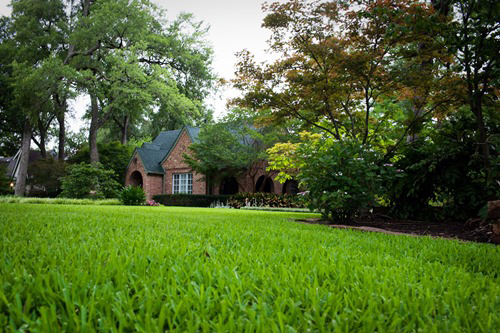If you love your lawn and like to do all your own yard work, it’s possible to sort out which fertilizers will help your yard—though it’s tough to figure out the best lawn fertilizer option without expert help. If you want to do it on your own:
Know what type of fertilizer to use.
- Complete fertilizers contain the three primary macronutrients; nitrogen, phosphorus, and potassium (N-P-K) in one product; many also contain other essential micronutrients.
- Balanced fertilizers contain the above three elements in the same amounts (10-10-10 or 15-15-15) and are often not ideal and a more customized ratio of N-P-K is required to meet the needs of your grass type. Recommended ratios may change by the season or may change based on the results of a soil nutrient test, but some common ratios include: 4-1-2, 5-1-3 or 5-0-3 in states where phosphorus use is banned.
- “Weed and Feed” fertilizer products contain N-P-K and broadleaf weed killer for common pests like dandelions and are only effective if the weeds are already growing.
- Pre-emergent lawn fertilizers contain N-P-K along with weed killers that must be applied before weeds germinate and will not harm weeds that are already actively growing. These products are commonly used to prevent crabgrass.
Follow lawn fertilizer application package directions.
Following the directions on the bag or box to make the fertilizer application is the safest way to apply fertilizer in a “DIY” setting. Too much fertilizer can “burn” your grass, leaving it brown or spindly. Too little lawn fertilizer can leave a yard prone to weed problems and thin growth. Striking the proper balance is essential for lawn care health. Label directions are put together by trained scientists and following them ensures you achieve professional results.
Give the lawn fertilizer application time.
The results of your lawn fertilization efforts may not show up immediately, but you should see some visible results in 7-10 days. Phosphorus and potassium won’t automatically promote greening, but will improve the long-term health of your lawn. Don’t fertilize again because you didn’t see immediate results—you’ll risk burning your lawn or setting your grass up for long-term lawn and grass disease issues. Generally fertilizer can be safely applied every 4-6 weeks depending on the fertilizer analysis and application rate. Some fertilizers may only need to be applied 2 - 3 times per growing season if they have a large component of slow-release nitrogen. If you do not see results after waiting a few weeks you may have a soil pH issue. Having a soil test performed by a professional company can tell you if the pH needs to be adjusted with lime or sulfur in order to maximize the benefits and results of fertilization.
Seek the help of lawn fertilization professionals and experts at TruGreen.
If your situation calls for expert or specialized assistance, the professional lawn care members at TruGreen® are ready to help and assist you in selecting the best type of fertilizer for your individual lawn's needs.



 Branch Finder
Branch Finder














 Back to all blogs
Back to all blogs
Facebook
X
Youtube
Copy Link
Email